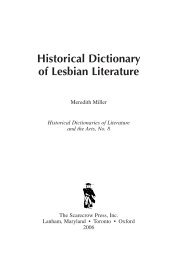Founded by Friends : the Quaker heritage of fifteen - Scarecrow Press
Founded by Friends : the Quaker heritage of fifteen - Scarecrow Press
Founded by Friends : the Quaker heritage of fifteen - Scarecrow Press
You also want an ePaper? Increase the reach of your titles
YUMPU automatically turns print PDFs into web optimized ePapers that Google loves.
xvi Thomas D. Hamm<br />
Hicksite <strong>Friends</strong>, perhaps because <strong>the</strong>y had in <strong>the</strong> 1820s seen <strong>the</strong>mselves<br />
responding to Orthodox compromises with “<strong>the</strong> world,” were<br />
slower to follow suit. Discussions <strong>of</strong> <strong>the</strong> Hicksite college that would become<br />
Swarthmore did not begin until <strong>the</strong> 1850s. And even <strong>the</strong>n, it may be<br />
significant that at <strong>the</strong> center <strong>of</strong> <strong>the</strong> movement were <strong>Friends</strong> like James and<br />
Lucretia Mott, who in <strong>the</strong> disputes <strong>of</strong> <strong>the</strong> 1840s over Hicksite involvement<br />
in reform movements had been seen <strong>by</strong> o<strong>the</strong>r Hicksites as dangerous radicals.<br />
The colleges that had <strong>the</strong>ir start after 1860 reflected different influences.<br />
Some—William Penn, George Fox, and Whittier—like <strong>the</strong> older Orthodox<br />
schools, began as academies or secondary schools. O<strong>the</strong>rs—Wilmington,<br />
<strong>Friends</strong> University, and Bryn Mawr—were founded as institutions <strong>of</strong><br />
higher education. They were, with <strong>the</strong> exception perhaps <strong>of</strong> Bryn Mawr,<br />
envisioned as institutions to serve <strong>Quaker</strong>s but in ways that were different<br />
from <strong>the</strong> older vision <strong>of</strong> a guarded education. To be sure, <strong>the</strong> founders<br />
<strong>of</strong> all saw <strong>the</strong>mselves as mixing faith and secular education, and all would<br />
have agreed it was <strong>the</strong> duty <strong>of</strong> a <strong>Quaker</strong> college to guard its students<br />
against evil influences, whe<strong>the</strong>r <strong>the</strong>y be moral or intellectual. But <strong>the</strong>y<br />
usually took as <strong>the</strong>ir intellectual models non-<strong>Quaker</strong> colleges and followed<br />
general trends in American higher education. All, save Bryn Mawr,<br />
were connected with Gurneyite yearly meetings that accepted <strong>the</strong> pastoral<br />
movement and gave some attention to training pastors. But all assumed<br />
that most <strong>of</strong> <strong>the</strong>ir students were bound for secular careers.<br />
The two notable exceptions are Malone and Barclay, which were reactions<br />
to developments in <strong>the</strong> o<strong>the</strong>r <strong>Quaker</strong> schools. These were Bible colleges,<br />
institutions that took decades to develop into four-year colleges,<br />
and only <strong>the</strong>n with considerable debate and some misgivings. They were<br />
designed to serve <strong>Friends</strong>, specifically pastoral <strong>Friends</strong>, <strong>by</strong> providing<br />
what was in essence a guarded education. In this case, that meant guarding<br />
against critical Bible study and o<strong>the</strong>r forms <strong>of</strong> modernism that were<br />
becoming increasingly influential in o<strong>the</strong>r colleges and seminaries, including<br />
o<strong>the</strong>r <strong>Quaker</strong> colleges, in <strong>the</strong> late nineteenth century. But like<br />
o<strong>the</strong>r <strong>Quaker</strong> colleges, <strong>the</strong> founders <strong>of</strong> <strong>the</strong>se two schools were also influenced<br />
<strong>by</strong> non-<strong>Quaker</strong> models, in this case <strong>the</strong> Bible colleges that became<br />
bulwarks <strong>of</strong> fundamentalist Protestantism in <strong>the</strong> early twentieth century.<br />
Moreover, while <strong>by</strong> 1900 <strong>the</strong> o<strong>the</strong>r <strong>Quaker</strong> colleges accepted that most <strong>of</strong><br />
<strong>the</strong>ir students were bound for secular careers, <strong>the</strong> schools in Cleveland<br />
and Haviland were designed to produce men and women who would<br />
make <strong>the</strong>ir careers as pastors or missionaries or in o<strong>the</strong>r forms <strong>of</strong> “Christian<br />
work.”<br />
Closely related to patterns <strong>of</strong> founding in determining <strong>the</strong> future <strong>of</strong><br />
<strong>the</strong>se schools were patterns <strong>of</strong> control. Surprisingly, only Guilford and<br />
Earlham were projects <strong>of</strong> <strong>the</strong>ir yearly meetings, and even <strong>the</strong>n <strong>the</strong> con
















